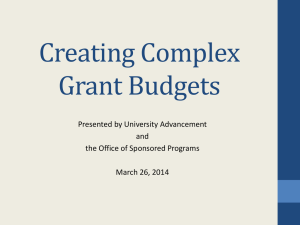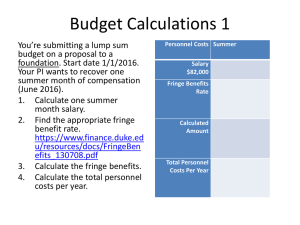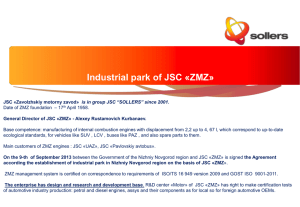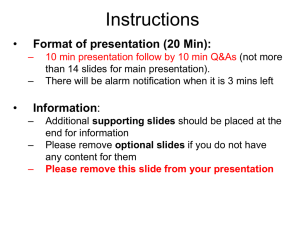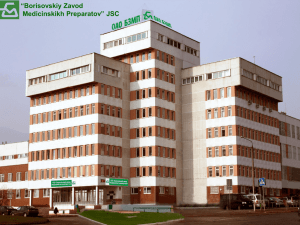2014-04-10 NCMA Source Selection Updates-rev1
advertisement
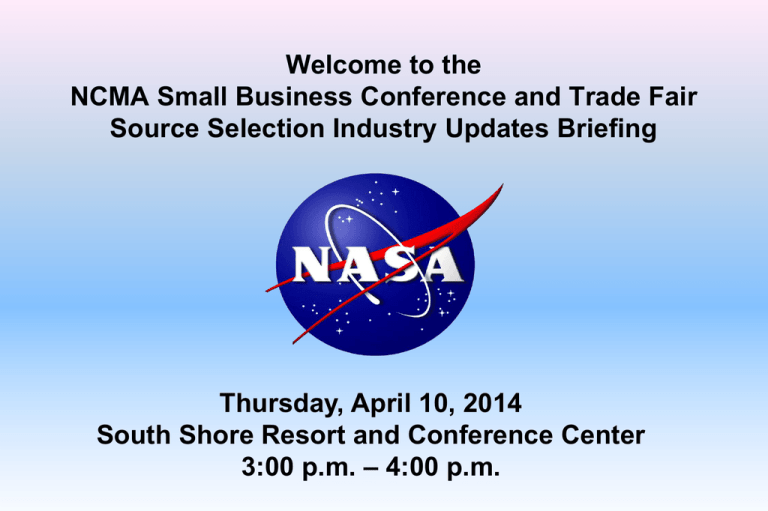
Welcome to the NCMA Small Business Conference and Trade Fair Source Selection Industry Updates Briefing Thursday, April 10, 2014 South Shore Resort and Conference Center 3:00 p.m. – 4:00 p.m. Disclaimer This briefing is provided for informational purposes only and does not apply to any specific solicitation. Each solicitation has its own set of Instructions, Conditions, and Notices to Offerors and Evaluation Factors for Award. When submitting proposals in response to a solicitation, carefully read the Instructions, Conditions, and Notices to Offerors and Evaluation Factors for Award for that particular solicitation. 2 Objective To communicate updates to the JSC Source Selection processes to help Industry better prepare and respond to the JSC Request for Proposals. 3 Agenda Speaker Anna Carter, Contracting Officer JSC Source Selection Office Wally Khan, Price Analyst JSC Source Selection Office Suzan P. Thomas, Contracting Officer and Contractor Industrial Relations Officer JSC Source Selection Office Subject Connections and Strengths in Discussions Pricing Updates & Indirect Rates Clarifications Tips for Avoiding Common Mistakes in Total Compensation Plans (TCPs) 4 Connections Anna Carter Contracting Officer JSC Source Selection Office 5 JSC Source Selection Office “CONNECTIONS” …Coming soon GOAL To increase transparency, the JSC Source Selection Office has identified a way to provide a platform for collaboration and innovation through the use of “Connections”. This web link will allow the Office of Procurement to post new ideas and solicit feedback from Industry aimed at improving the efficiency and effectiveness of future competitive processes. The desire is to foster working level exchanges, in addition to executive communiques. The intent of “Connections” is to publish information based on those topics or ideas that would better serve the contracting community as a whole. INTENDED USES • This tool will provide the Office of Procurement an avenue to seek feedback and/or socialize new processes or initiatives. – Thumb drives vs. CD’s – Strengths in Discussions – Average SLC rate data in the technical library • This tool is not intended to solicit feedback or questions about ongoing competitive acquisitions. Strengths Provided in Discussions To enhance our potential for increasing best value, a pilot program of providing strengths during “discussions” will begin with the Communications, Outreach, Multi-media & Information Technology (COMIT) procurement. We want to hear from you! Point of Contact: Anna Carter JSC Source Selection Office Phone: (281) 483-1869 Email: Anna.Carter-1@nasa.gov Pricing Updates & Indirect Rates Clarifications Wally Khan Cost/Price Analyst JSC Source Selection Office 11 Incumbent Retention Data • Total Compensation Template (e): Incumbency Assumptions [TC(e)] was revised to better support the data collection needed to fully understand an offeror’s strategy regarding incumbent retention and compensation. • Lack of clarity regarding an offeror’s proposed approach can result in – prolonged discussion periods – a slip in planned award date • Recent changes to how incumbent data is captured in solicitations: – TC(e) revision – Technical Resources Template (TRT) revision – Inclusion of ‘incumbent’ definition in RFP: “current person performing same or similar function on current contract” 12 NEW TC(e): Incumbency Assumptions Compensation Template (e): Incumbency Assumptions [ ] Prime Contractor: [ ] Major Subcontractor: [ ] Minor Subcontractor: Incumbent Retention Labor Rates Seniority Rights Proposing to fill __% of positions with incumbents. Proposing to fill __% of positions with non-incumbents. Proposing to pay __% of incumbents current incumbent direct labor rates. Proposing to pay __% of incumbents other than current incumbent direct labor rates. Proposing to maintain seniority rights for fringe purposes for __% of incumbents. Proposing to not maintain seniority rights for fringe purposes for __% of incumbents. Note 1: Offeror team members shall fill in all fields in each category above. Ensure that you provide supporting rationale with specific details, in narrative form, explaining the proposed approach indicated above. 13 NEW Sample TRT Sample TECHNICAL RESOURCES TEMPLATE (TRT) Prime Contractor Name: SOW 3.0 Engineering Projects PRIME AND ALL SUBCONTRACT (INCLUDING MINOR SUBCONTRACTORS) RESOURCES COMBINED NASA (JSC) Standard Labor Category WYEs Program Manager Management/Supervisor Engineer V Engineer IV Engineer II Engineer I Technician III Technician II Technical Professional IT/Database Professional IT Professional Business Specialist (non G&A) Professional/Administration Administrative Specialist Clerical/Secretary Other: (Specify) Other Total WYE Prime and All Subs Incumbent Retention % % Incumbents at SOW (Roll-up) Current DL Rates 3.0 SOW 3.1.1 SOW 3.1.2 SOW 3.1.3 SOW 3.7 Skill mix Ratio #DIV/0! - - - - - - - - - - - - - - - - - - - - - - - - - - - - - - #DIV/0! #DIV/0! #DIV/0! #DIV/0! #DIV/0! #DIV/0! 0 #DIV/0! 0 #DIV/0! 0 #DIV/0! 0 #DIV/0! 0 - 14 Future Pricing Changes • In the interest of further streamlining the source selection process, the Government is exploring alternative approaches to providing offerors’ feedback on incumbent direct labor rates. 15 Indirect Rates • • • • • Indirect rates in proposals Three years prior rates Trend Causes of increasing or decreasing rates Review the development of rates and presentation in proposals 16 Typical Indirect Rates • Fringe Rate(s) – an indirect rate that captures the cost of employee benefits • Overhead Rate(s) – an indirect rate that relate(s) to the product or service being produced but cannot be realistically charged on a direct basis. May include Fringe Costs as well. • General and Administrative Rate – an indirect rate that usually relates to costs to the company as a whole. 17 Indirect Rate Structure Pool Common Pools: 1) Fringe Costs 2) Overhead Costs 3) G&A Costs • Calculation: Indirect Rate = Indirect Cost Pool = $150 = 30% Allocation Base $500 Common Bases: 1) Direct Labor Hours 2) Direct Labor Costs 3) # of Units Produced 4) # of Machine Hours Base Burden Total Cost Input = All Cost except G&A Value added Input = Generally Total Cost Input less materials and subcontracts 18 Fringe Rates • Employee fringe benefit costs (e.g., payroll taxes, vacation, sick, retirement, health care, bonus, deferred compensation, insurance, etc.) • Calculation: Fringe Rate = Fringe Pool Total Labor Dollars 19 Overhead Rate • Management or supervision of activities or cost of certain segments of a business unit that benefit more than one project, contract or award, but not the business unit as a whole (e.g., division middle management, supervisors, project leadership benefiting multiple projects, site rent, etc.) • These are costs that would not be incurred if it was not for the awarded contract • Calculation: Overhead Rate = Overhead Pool Loaded Direct Labor Dollars 20 G & A Rate • Management and administration costs that benefit the business unit as a whole (e.g., Accounting, H.R., OCFO, Legal, Chief Executive Officer, B&P) • Costs for running the business • Calculation: G&A Rate = G&A Pool . Total Cost Input • Other basis include value-added cost input 21 Tips for Avoiding Common Mistakes in Total Compensation Plans (TCPs) Suzan P. Thomas Contracting Officer and Contractor Industrial Relations Officer JSC Source Selection Office 22 Regulatory Requirements • FAR 52.222-46: – “Professional compensation that is unrealistically low or not in reasonable relationship to the various job categories, since it may impair the Contractor’s ability to attract and retain competent professional service employees, may be viewed as evidence of failure to comprehend the complexity of the contract requirements.” • The standard TCP Data Requirements Description (DRD) states: “The TCP and Total Compensation Templates (a) through (e) shall be required for both the prime team members and all subcontractors that meet the criteria in NFS 1852.231-71(d).” – Many proposals lack the required subcontractor TCPs and Templates, making it difficult to evaluate the offeror’s responsiveness in this area. 23 Page Limits • We have eliminated page limits for TCPs because we could not identify a page limit that would level the playing field for all offerors. – Some offerors propose no subcontractors, some propose one, and others propose numerous subcontractors. – Use your best business judgment to ensure that you have addressed all areas of the TCP DRD. 24 Specific Fringe Benefits • Be specific when describing each fringe benefit offered to employees. − When is the employee eligible for the benefit? − What is the specific benefit offered? For example: “We offer company paid life insurance” versus “We offer company paid life insurance in the amount of 1 times the employees annual salary.” − What percentage is paid by the company and what percentage is paid by the employee? • Also be specific when describing employee paid benefits. − For example, if short-term disability insurance is “employee paid”, then discuss the specific benefit offered, and how much the employee will pay for this benefit. − If a job is physical in nature, and disability insurance is not covered, then discuss why. 25 Wage Determinations • It is the offeror’s responsibility to identify and map their non-exempt labor categories to an appropriate category in the wage determination. – Use the Service Contract Act Directory of Occupations, 5th Edition at: http://www.dol.gov/whd/regs/compliance/wage/SCADirV5/SCADirectVer s5.pdf • Pay attention to the Service Contract Act Health & Welfare Benefit in the wage determination. – The current benefit is $3.81 an hour. Many proposals include an amount that is lower and usually matches the prior year’s amount. 26 Total Compensation Templates • Ensure consistency between the TCP and the Compensation Templates. − For example, if the TCP states that life insurance is offered to employees, and TC(c), Fringe Benefit Analysis Package states: “0.00” under the cost of the fringe benefit, then there is an inconsistency. − Ensure that the benefit offered to employees in the TCP are consistent with the benefits offered to employees in TC(d) Personnel and Fringe Benefit Policies. TC(d) is intended to be a summary of benefits for the convenience of the evaluators. 27 Standard Labor Categories • • Ensure that you understand the description and relative responsibility level of each standard labor category. Ask the Contracting Officer if the RFP is not clear. − We look at the offeror’s description of the labor categories and the labor rates proposed for each labor category to determine if the offeror understands the work to be performed and the relative responsibility levels of the labor categories. 28

